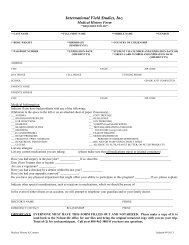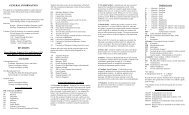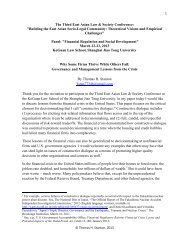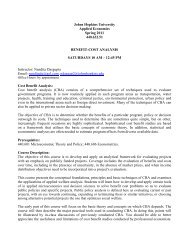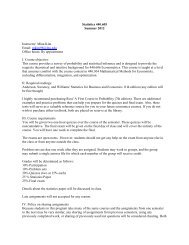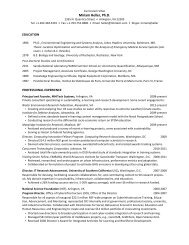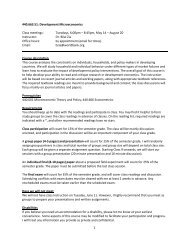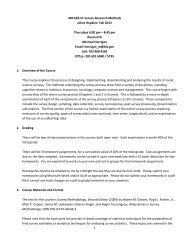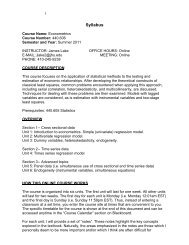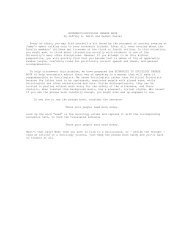Principles and Applications of Energy Technology - Advanced ...
Principles and Applications of Energy Technology - Advanced ...
Principles and Applications of Energy Technology - Advanced ...
You also want an ePaper? Increase the reach of your titles
YUMPU automatically turns print PDFs into web optimized ePapers that Google loves.
<strong>Energy</strong> Science (Andrews <strong>and</strong> Jelley (2007)). Chapter 2 – Thermal <strong>Energy</strong>: Sections 2.3, 2.4. onefficiency <strong>of</strong> thermal power plants Chapter 10: Section 10.1* on power generation, Chapter 11,Section 11.2 on economics <strong>of</strong> power plants.4: Wind Power <strong>and</strong> HydroThe majority <strong>of</strong> this class will cover wind power. Specifically, it will cover the science behind thetechnology (“how it works”), the economics <strong>and</strong> environmental impact <strong>of</strong> wind farms <strong>and</strong> also discusssome market structure, policy <strong>and</strong> resource considerations, including the use <strong>of</strong> economic incentives (suchas production tax credits (PTCs)), technological improvements, installed capacity <strong>and</strong> how changingfossil fuel prices <strong>and</strong> other commodity costs are affecting the relative <strong>and</strong> absolute economics <strong>of</strong> thistechnology. The latter part <strong>of</strong> the class will cover hydroelectric power which has some interestingsimilarities <strong>and</strong> differences to wind.Note: A similar approach – with varying degrees <strong>of</strong> detail <strong>and</strong> rigor, will be used for other technologiesWiser, Ryan <strong>and</strong> Bollinger, Mark, 2010 Wind Technologies Market Report, Lawrence BerkeleyNational Laboratory for the U.S Department <strong>of</strong> <strong>Energy</strong>, <strong>Energy</strong> Efficiency <strong>and</strong> Renewable <strong>Energy</strong>,June 2011. http://eetd.lbl.gov/ea/emp/reports/lbnl-4820e.pdfBonneville Power Administration, Hydropower: How the Federal Columbia River Power Systemworks for you, (2011)*. http://www.bpa.gov/corporate/pubs/Hydro_101.pdf,http://www.bpa.gov/power/pg/fcrps_brochure_17x11.pdfStone, Richard. “Three Gorges Dam: Into the Unknown” Science, 321, August 2008.Department <strong>of</strong> <strong>Energy</strong>, “Executive Summary <strong>and</strong> Overview”, 20% Wind <strong>Energy</strong> by 2030: IncreasingWind <strong>Energy</strong>’s Contribution to U.S. Electricity Supply, DOE/GO-102008-2567, May 2008*.http://www1.eere.energy.gov/wind<strong>and</strong>hydro/pdfs/41869.pdf (Supplementary reading - Optional)<strong>Energy</strong> Science (Andrews <strong>and</strong> Jelley (2007)). Chapter 5 - Wind Power: Sections 5.1 to 5.5, 5.7* <strong>and</strong>5.9 to 5.16, <strong>and</strong> Chapter 4 - Hydropower, Wave Power <strong>and</strong> Tidal Power: Sections 4.1, 4.2, 4.4.1 <strong>and</strong>4.5 for hydropower <strong>and</strong> 4.6*, 4.7 <strong>and</strong> 4.8 for tidal power.5: Solar <strong>Energy</strong>The majority <strong>of</strong> this class will cover solar energy <strong>and</strong> focus on the two main technologies – Photovoltaiccells (PV) <strong>and</strong> Concentrated Solar Power (CSP), with more emphasis on the former, including its use asdistributed or grid-independent resources. As for wind the class will cover the science (“how it works”),economics <strong>and</strong> environmental impact <strong>of</strong> solar technologies <strong>and</strong> also discuss some market structure, policy<strong>and</strong> resource considerations. PV discussion will range from single cell silicon PV to the use <strong>of</strong> multijunctioncells (<strong>of</strong>ten) in concentrated PV.McConnell, Robert <strong>and</strong> Symko-Davis, Martha, “ What’s New in Concentrating PV” , PV FAQ, U.SDepartment <strong>of</strong> <strong>Energy</strong>, <strong>Energy</strong> Efficiency <strong>and</strong> Renewable <strong>Energy</strong> (2008).Kutcher, Charles F. “Chapters on CSP <strong>and</strong> PV”, Tackling Climate Change in the U.S.: PotentialCarbon Emissions Reductions from <strong>Energy</strong> Efficiency <strong>and</strong> Renewable <strong>Energy</strong> by 2030, AmericanSolar <strong>Energy</strong> Society, January 2007. http://ases.org/images/stories/file/ASES/climate_change.pdf(Supplementary reading - Optional)<strong>Energy</strong> Science (Andrews <strong>and</strong> Jelley (2007)). Chapter 6 - Solar <strong>Energy</strong>: Sections 6.1, 6.2, 6.3*, 6..4,6.5, 6.6, 6.7.2, 6.8, 6.9, 6.10, 6.11DRAFT, August 23 rd 2012 (original version January 11, 2010, <strong>and</strong> previously updated August 24, 2010 <strong>and</strong>May 20 , 2011, <strong>and</strong> January 6, 2012). Based in part with modifications on course instructor developed forEnvironmental Challenges for <strong>Energy</strong> <strong>Technology</strong> <strong>and</strong> Policy (Original syllabus drafted September 1 st 2008,updated August 15 th 2009)




